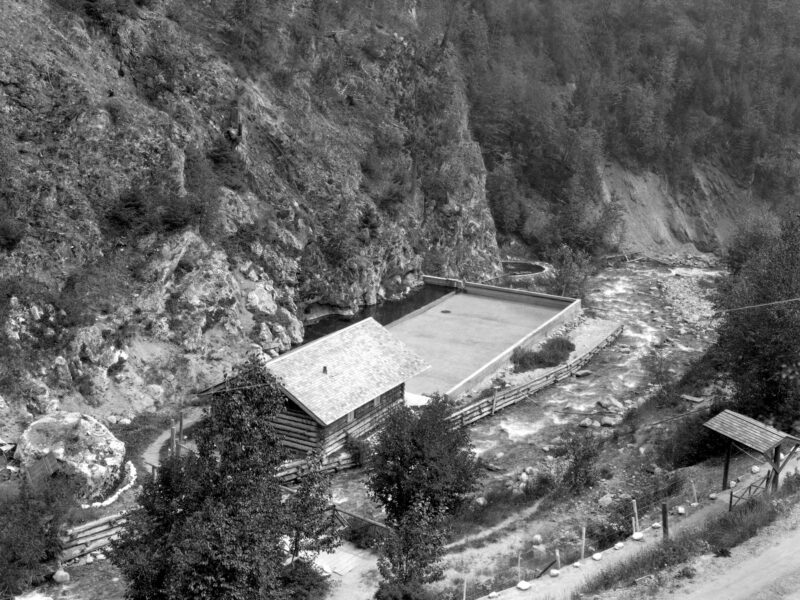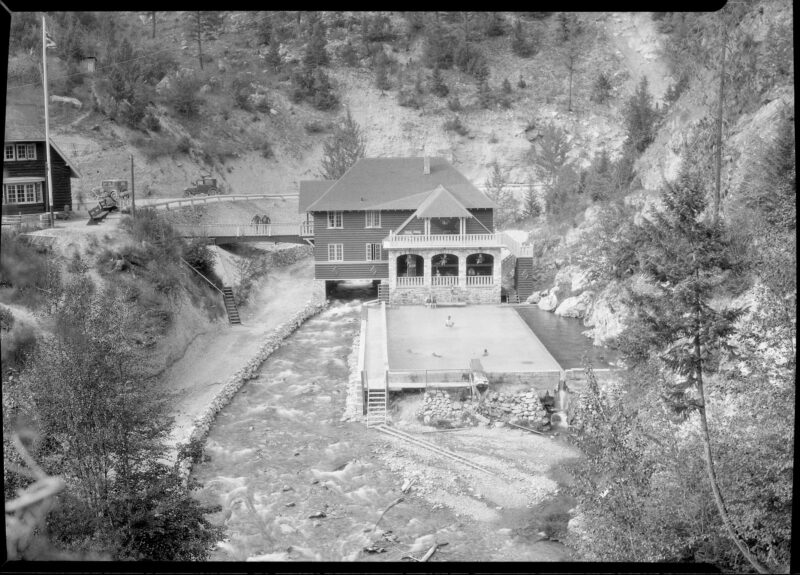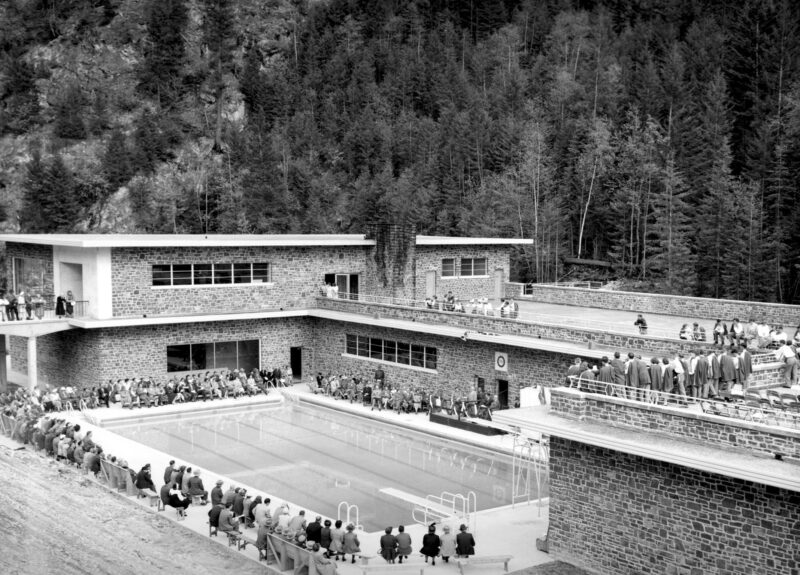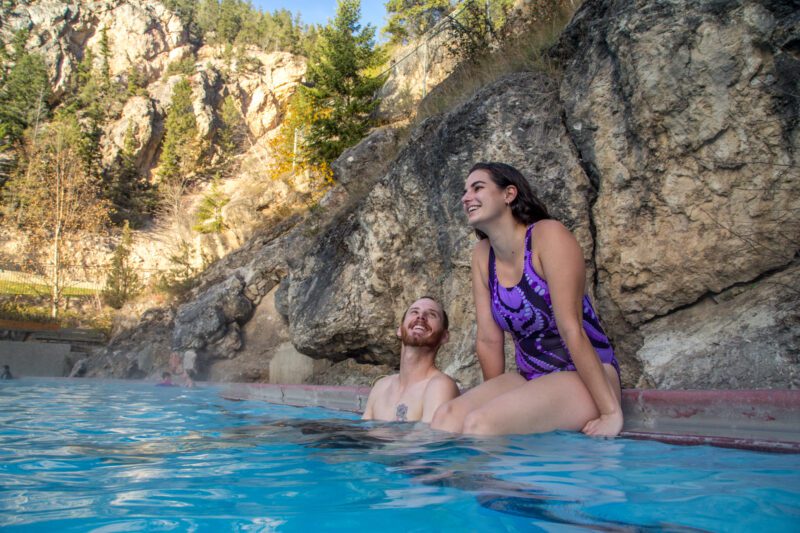Healing Waters and History: Radium Hot Springs Aquacourt
Located in Kootenay National Park, the pools at Radium Hot Springs Aquacourt feature hot mineral waters nestled in a dramatic canyon setting.
No hiking boots are required to visit this accessible attraction for all ages and abilities. Odorless mineral waters flow year-round; fall and winter bring rising steam on cold mornings, and with summer, sunbathing and cold plunges help visitors beat the heat.
Read on to soak in the history of the facility, the improvements being made, and how you can experience these historic mineral waters.

1923 Radium Hot pool with log dressing room
History
Since time immemorial, the hot springs have been a site of health and relaxation for Indigenous peoples. Since the late 1800s, visitors to the area have enjoyed the hot springs, from dipping in natural rock pools to a concrete pool with a log bathhouse, and the current ‘modernist style’ 1951 Aquacourt.
The first registered property owner of the springs from 1880-1922 was Roland Stuart. He initially named the location Sinclair Springs for the spring's proximity to the iconic Sinclair Canyon (the namesake of John Sinclair, an early settler in the area). Later the location was renamed Radium Hot Springs following the discovery of trace amounts of radon in the water. Visitors flocked to “take the healing waters”, popularized by the famous Banff Upper Hot Springs counterpart.
The hot springs were a driving force in the development of Kootenay National Park, the Banff-Windermere Highway (93s), and in the establishment of the Radium Hot Springs townsite. The early 1920s were marked by the explosion of automobile tourism. With the completion of the Banff-Windermere Highway in 1923, a new Tudor/rustic-style bathhouse was developed by the National Parks branch serving weary road travelers. In 1949, fire destroyed this building, making way for the current Aquacourt.

Radium Hot Springs 1926/27 Bathouse and pool. Credit Byron Harmon, Whyte Museum
The modernist-style Aquacourt was the first major post-war building project in the western mountain parks. It took three years to complete. When the building opened in 1951, it featured steam and massage rooms, a coffee bar, an elevator for wheelchair-bound patients, a roof terrace for sunbathers and spectators, and a new cool pool equipped with three diving boards and underwater lighting. By the late 1950’s the Aquacourt was a center of activity in the Columbia Valley, featuring everything from precision diving displays to swim meets, concerts on the sundeck, and interpretive film screenings.
Today, the design features of the Aquacourt have been preserved and maintained as a Classified Federal Heritage Building. Over 70 years after opening, visiting the Radium Hot Springs Aquacourt remains a must-see attraction in Kootenay National Park.

A view of the cool pool during the 1951 Aquacourt opening
Revitalization
Visitors to the Aquacourt in 2023 may be familiar with signs of construction and an imposing blue crane towering over the site. The hot pool remains open while the facility’s 25m cool pool is undergoing a much-needed makeover.
Recent improvements to revitalize the 1951 building include:
- Modernized changerooms
- A new rooftop sundeck
- The introduction of green technology to capture excess geothermal energy generated by the hot spring
- Protection of the building foundation from the rushing water of Sinclair Creek which runs underneath the structure.
The cool pool is also being modernized as it has not seen upgrades in 25 years. When construction is complete in the fall/winter of 2023, visitors will enjoy improved amenities including heated decks, faster lane swim experience with reduced waves, and an accessible lift for mobility-limited users.
Major investments in the restoration of the Radium Hot Springs Aquacourt ensure this heritage experience is available for future generations of Canadians to enjoy.

How to visit
Radium Hot Springs is accessible to a wide range of visitors, from families to those with mobility restrictions. From the larger parking lot (north side of Highway 93s) take the stairs into a tunnel for an interpretive journey about wildlife and crossing structures, great for families with young kids. Alternatively, a ramp from the smaller parking lot (south side of Highway 93s) allows wheels to roll to the entrance with ease from accessible parking stalls.
When traveling in Kootenay National Park, consider taking a dip in these natural and historical waters. During construction, the hot pool remains open, and a cold plunge pool provides a way to beat the heat.
Entry to Radium Hot Springs is first come, first served and admission may only be purchased in person at reception. Towels and both modern and 1920s heritage-styled swimsuits are available for rent for the perfect photo op. The facility is open year-round, including on all Canadian Holidays.
For hours of operation and pricing, visit hotsprings.ca
Learn more about accessibility at Radium Hot Springs here.

